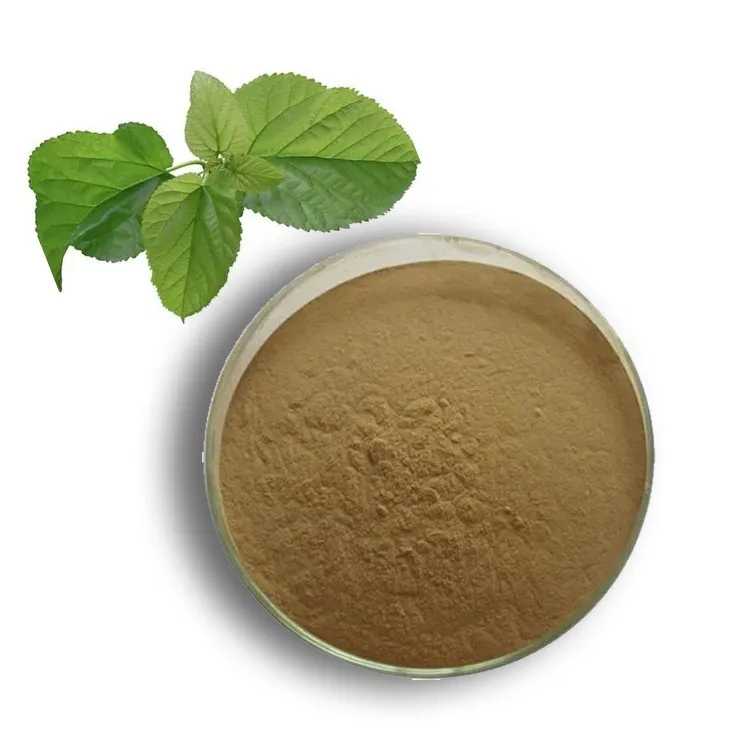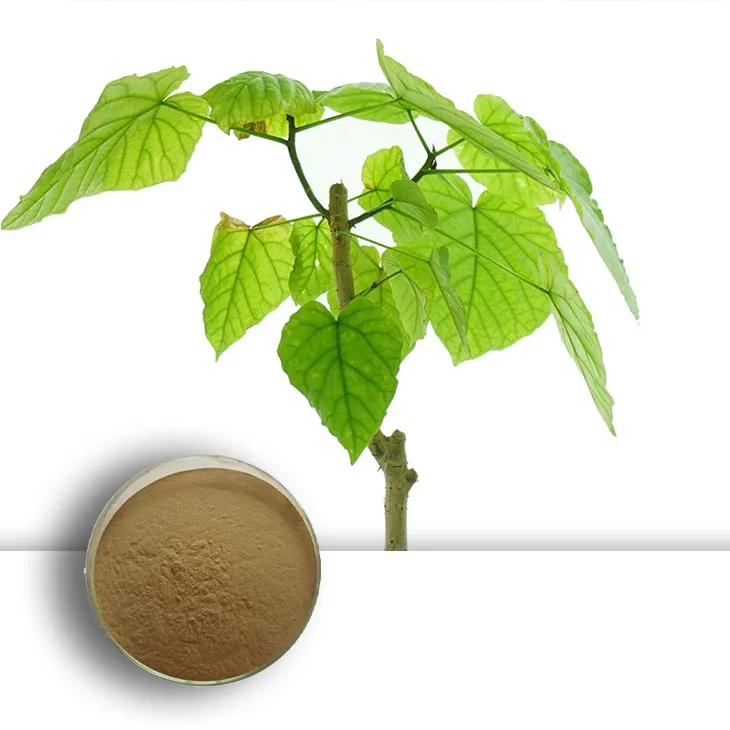- 0086-571-85302990
- sales@greenskybio.com
Components of mulberry leaf extract in fertilizers and feeds.
2024-11-26

1. Introduction
The mulberry tree has been known for centuries for its various uses. Mulberry leaf Extract is emerging as a valuable component in both fertilizers and feeds. In the agricultural field, the search for effective and sustainable fertilizers is ongoing, and Mulberry leaf Extract offers potential solutions. Similarly, in livestock rearing, the need for nutritious and cost - effective feed ingredients is ever - present, and this extract has shown great promise.

2. Components of Mulberry leaf Extract
2.1 Nutrients
Mulberry leaves are rich in a variety of nutrients. They contain significant amounts of nitrogen (N), phosphorus (P), and potassium (K), which are the primary macronutrients essential for plant growth. In terms of nitrogen, it is a crucial element for the formation of plant proteins and chlorophyll. Phosphorus is involved in energy transfer and storage within the plant cells, as well as in DNA and RNA synthesis. Potassium helps in regulating plant water balance, enzyme activation, and improving plant resistance to diseases and pests.In addition to these macronutrients, mulberry leaf extract also contains micronutrients such as iron (Fe), manganese (Mn), zinc (Zn), and copper (Cu). These micronutrients play vital roles in plant physiological processes, albeit in small quantities. For example, iron is necessary for chlorophyll synthesis, while zinc is involved in enzyme activity and hormone regulation in plants.
2.2 Bioactive Compounds
Mulberry leaves are a source of numerous bioactive compounds. One of the prominent ones is flavonoids. Flavonoids are polyphenolic compounds with antioxidant properties. They can scavenge free radicals in plants, protecting them from oxidative stress. In the context of livestock feed, flavonoids can also have positive effects on animal health. For example, they may enhance the antioxidant capacity of the animal's body, reducing the risk of various diseases.Another important bioactive compound in mulberry leaf extract is alkaloids. These compounds can have pharmacological effects. In plants, they may play a role in defense mechanisms against pests and diseases. In livestock, alkaloids may influence the metabolism and physiological functions of animals, although further research is needed to fully understand their impact.

3. Mulberry Leaf Extract as a Fertilizer Component
3.1 Improvement of Soil Fertility
When used as a fertilizer component, mulberry leaf extract can enhance soil fertility in multiple ways. The nutrients present in the extract, such as nitrogen, phosphorus, and potassium, are directly supplied to the soil. This enriches the soil, making it more suitable for plant growth. Moreover, the organic matter in the extract improves soil structure. It helps in increasing soil porosity, which in turn promotes better root penetration and aeration.The presence of bioactive compounds in the extract also benefits the soil. For example, flavonoids can stimulate the growth of beneficial soil microorganisms. These microorganisms play important roles in nutrient cycling and decomposition of organic matter in the soil.
3.2 Promotion of Plant Growth
The nutrients and bioactive compounds in mulberry leaf extract contribute to promoting plant growth. The macronutrients help in the development of plant tissues, including leaves, stems, and roots. For instance, adequate nitrogen supply leads to lush green foliage, while potassium promotes strong root growth.The bioactive compounds can also have a direct impact on plant growth. Flavonoids, with their antioxidant properties, can protect plants from environmental stresses such as drought and high temperature. This allows plants to maintain normal growth and development even under adverse conditions.
3.3 Enhancement of Plant Resistance
Mulberry leaf extract can enhance plant resistance to pests and diseases. The alkaloids present in the extract may act as natural pesticides. They can repel or inhibit the growth of certain pests, reducing the need for chemical pesticides.Additionally, the antioxidant properties of flavonoids help plants to build up their defense mechanisms against diseases. A stronger antioxidant system in plants can prevent the damage caused by pathogens and enhance the plant's overall immunity.

4. Mulberry Leaf Extract as a Feed Ingredient
4.1 Nutritional Value for Livestock
As a feed ingredient, mulberry leaf extract offers significant nutritional value to livestock. The presence of nutrients such as protein, vitamins, and minerals makes it a valuable addition to animal feed. The protein in mulberry leaves is of good quality, containing essential amino acids required by animals for growth, development, and maintenance of body functions.Vitamins such as vitamin C and vitamin E are also present in the extract. These vitamins play important roles in animal health. Vitamin C is involved in collagen synthesis and immune function, while vitamin E is a powerful antioxidant that protects cells from oxidative damage.
4.2 Impact on Animal Health
The bioactive compounds in mulberry leaf extract have positive impacts on animal health. Flavonoids, as mentioned earlier, can enhance the antioxidant capacity of animals. This can reduce the incidence of oxidative - related diseases such as mastitis in dairy cows.Alkaloids may also have an impact on animal metabolism. They could potentially influence the digestion and absorption of nutrients in the animal's digestive tract, although more research is required to determine the exact mechanisms.
4.3 Economic Benefits for Livestock Producers
Incorporating mulberry leaf extract into animal feed can bring economic benefits to livestock producers. Firstly, it can potentially reduce the cost of feed, as mulberry leaves are relatively easy to obtain in some regions. Secondly, the improved health and performance of livestock due to the consumption of mulberry leaf extract - containing feed can lead to increased productivity. For example, better growth rates in meat - producing animals or increased milk production in dairy cows can result in higher revenues for farmers.5. Conclusion
In conclusion, mulberry leaf extract has a rich composition of nutrients and bioactive compounds. As a component of fertilizers, it can improve soil fertility, promote plant growth, and enhance plant resistance. As a feed ingredient, it offers nutritional value, impacts animal health positively, and brings economic benefits to livestock producers. However, further research is still needed to fully explore its potential and optimize its applications in both the agricultural and livestock sectors.
FAQ:
What are the main components of mulberry leaf extract in fertilizers?
Mulberry leaf extract in fertilizers may contain various components. It often has rich nutrients such as nitrogen, phosphorus, and potassium in small amounts. Additionally, it may have organic compounds like flavonoids, polyphenols, and amino acids. These components can improve soil fertility, enhance plant growth, and contribute to the overall health of plants.
How do the components of mulberry leaf extract in fertilizers benefit plants?
The nitrogen in the extract can help with leaf and stem growth. Phosphorus is crucial for root development and flowering. Potassium improves the plant's resistance to diseases and stress. Flavonoids and polyphenols may act as antioxidants in the soil, protecting plants from harmful free radicals. Amino acids can be directly absorbed by plants and used in protein synthesis, promoting overall plant vigor.
What are the components of mulberry leaf extract in feeds?
In feeds, mulberry leaf extract contains high - quality proteins, essential amino acids, vitamins (such as vitamin C, E, etc.), and minerals (like calcium, potassium). It also has bioactive compounds like flavonoids. These components make it a valuable addition to livestock feed, providing a rich source of nutrition for animals.
How does mulberry leaf extract in feeds improve livestock health?
The high - quality proteins and essential amino acids in the extract are important for muscle development and growth in livestock. Vitamins and minerals help maintain normal physiological functions. Flavonoids may have antioxidant and anti - inflammatory properties, which can enhance the immune system of animals, making them more resistant to diseases and improving their overall health.
Are there any potential drawbacks to using mulberry leaf extract in fertilizers or feeds?
One potential drawback in fertilizers could be improper application rates. If too much extract is used, it may lead to nutrient imbalances in the soil. In feeds, some animals may initially be unaccustomed to the taste of mulberry leaf extract, which could potentially affect their feed intake. However, with proper acclimation and formulation, these issues can usually be overcome.
Related literature
- Title: Analysis of Nutritional Components in Mulberry Leaf Extract for Agricultural Applications"
- Title: "The Role of Mulberry Leaf Extract in Livestock Feed: A Comprehensive Review"
- Title: "Beneficial Compounds in Mulberry Leaf Extract for Fertilizer Enhancement"
- ▶ Hesperidin
- ▶ citrus bioflavonoids
- ▶ plant extract
- ▶ lycopene
- ▶ Diosmin
- ▶ Grape seed extract
- ▶ Sea buckthorn Juice Powder
- ▶ Beetroot powder
- ▶ Hops Extract
- ▶ Artichoke Extract
- ▶ Reishi mushroom extract
- ▶ Astaxanthin
- ▶ Green Tea Extract
- ▶ Curcumin Extract
- ▶ Horse Chestnut Extract
- ▶ Other Problems
- ▶ Boswellia Serrata Extract
- ▶ Resveratrol Extract
- ▶ Marigold Extract
- ▶ Grape Leaf Extract
- ▶ blog3
- ▶ blog4
-
Chinese Withania somnifera Extract Factory.
2024-11-26
-
中国松树皮提取物粉粉末供应商
2024-11-26
-
High - quality Marigold Extract Products.
2024-11-26
-
100% Pure Natural Mango - Flavored Powder.
2024-11-26
-
Aminolevulinic acid
2024-11-26
-
Chaste Berry Extract
2024-11-26
-
Moringa powder
2024-11-26
-
Mulberry leaf Extract
2024-11-26
-
Coconut Water Powder
2024-11-26
-
White Willow Bark Extract
2024-11-26
-
Fenugreek Extract Powder
2024-11-26
-
Sophora Flavescens Root Extract
2024-11-26
-
Uridine-5'-monophosphate Disodium salt
2024-11-26
-
Panax Ginseng Leaf Extract
2024-11-26




















